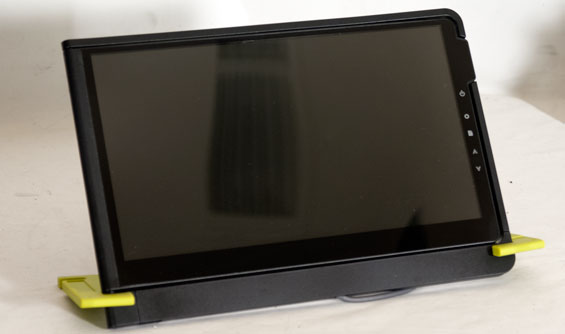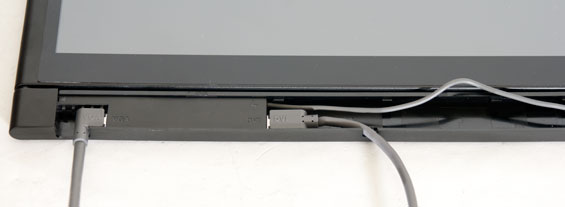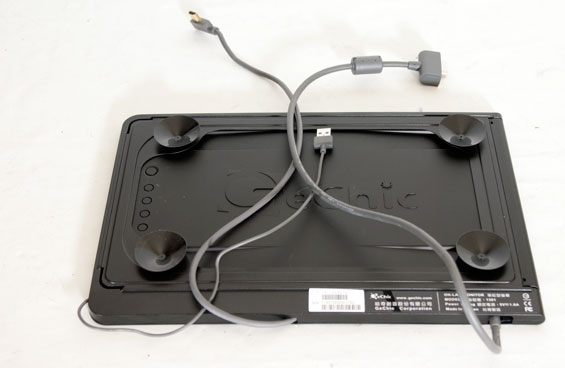Capsule Review: GeChic's On-Lap 1301 Laptop Monitor
by Dustin Sklavos on January 19, 2012 2:16 AM EST- Posted in
- Laptops
- Peripherals
- LCD
- gechic
Introduction
Recently Taiwanese vendor GeChic got in touch with us about a new product set to appear on American shores, the On-Lap 1301 laptop monitor. The concept? A portable 13" screen that affixes to the back of your notebook lid and swings out, extending your desktop space and powered by a USB 2.0 cable. The first inclination is to expect another DisplayLink peripheral, but the On-Lap 1301 actually uses HDMI or VGA out from your notebook, and thus dodges all of the pitfalls of using a USB-driven screen. So how effective is the On-Lap 1301? We took it for a test drive to find out if GeChic's screen is the productivity enhancer you were looking for.

Installation
GeChic is presently an exceedingly small company with just one product to their name, and that’s the one we have on hand. The On-Lap 1301 is a 13” screen that can use either suction cups to affix to the back of your notebook lid and hinge outward, or stand up using included rubber green stands. The On-Lap is basically as fresh as it gets; the instruction manual’s English is understandable, though a bit tenuous at times and occasionally light on detail. Still, it’s easy enough to divine how to use the screen. You can opt to use the included rubber green stands, but you’ll find them problematic for a variety of reasons we’ll get into in a bit.

First, there’s connecting the On-Lap. The only cables included in the box are the VGA and HDMI dongles; the USB power cable is tucked into a small area beneath the screen. There’s a panel that slides off, and from there you extend the cable out of the side. To the left are the two internal connectors for the screen, but this is where the On-Lap runs into its first major problem: both cables are routed out of the bottom of the screen, essentially making the stands next to impossible to use as the screen itself will always be propped up on the display cable itself. That’s probably fine, though; the stands themselves are flimsy and don’t have any direct way to actually connect to the screen, making them impractical in real world use. They strike me as an afterthought; the On-Lap is clearly designed to be affixed to the back of your notebook lid.

On that front things look much better. Four suction cups get screwed into the back of the mount, and the suction cups themselves are actually extremely effective. GeChic includes mylar pads which you can affix to your notebook lid (and then affix the suction cups to the pads), but I found them inessential: the flat surface of my ThinkPad’s lid was perfectly fine and suction was more than adequate. This is really the ideal way to use the On-Lap, with the screen hinging out to the right. It looks more than a little awkward on my 11.6” ThinkPad, but just about any 13” ultrabook or portable should be just fine. As for weight, while the On-Lap is about two pounds, I found that most notebooks should still be able to handle the weight without tipping. Since you can adjust how far out the screen swings and the screen itself is the heavy part, it’s not difficult at all to balance the two together.










31 Comments
View All Comments
PhoenixEnigma - Saturday, January 21, 2012 - link
Would be neat to stick to the side of a LAN party box, too. You could certainly do better for the price display-wise, but the convenience is second to none, and it would look neat on the side of a SFF PC.Nihility - Saturday, January 21, 2012 - link
I'm worried that adding 2 pounds of weight to the already flimsy hinges of a laptop would damage it over time.Especially because that weight is added at an angle creating a lot of torque.
Out of Box Experience - Sunday, January 22, 2012 - link
Normal USB monitors cannot output a display untill the USB drivers loadBut THIS could be used as a portable diagnostic monitor when you are unsure if you have a computer problem or a monitor problem
ANY 5 volt X 1 Amp USB power supply (Battery or AC) could power the monitor and the you would get instant display capeability for accessing BIOS screens before the USB drivers kick in
Portable, Extremely Low Power, Instant On.....
Whats not to like?
CZroe - Sunday, January 22, 2012 - link
Back when LCD desktop monitors were uncommon but larger LCD panels were common in notebooks, I was angry that no notebooks have VGA or DVI input, especially considering that they were the most expensive part in a notebook by far and they could help justify the cost. I remember it being a lot of trouble to troubleshoot someone's computer if I needed to try another monitor and I only brought my laptop and some tools (who's going to pack up a CRT unless they know it's needed ahead of time?).I still wonder why no one has yet done this.
eh_ch - Friday, February 3, 2012 - link
+1FXi - Sunday, January 22, 2012 - link
It would cost peanuts for any of the giants, Samsung or LG to offer screens of this nature. I won't be surprised if this market gets a bunch of additional competitors since laptops are more than 50% of the market and growing.Finraziel - Monday, January 23, 2012 - link
I was actually searching for something like this a while ago, though not for it being portable... What I was trying to find was a compact monitor for use at home in the living room, to use the HTPC when the TV was in use by someone else, that could easily be stowed away when not in use. Since I'd also want to play games on it from time to time, all of those USB monitors can't be used, but this would be quite interesting.7Enigma - Monday, January 23, 2012 - link
You could run off a single one if mobile (along with the negatives of brightness/etc.) but if connected by AC you could plug in the second for additional brightness.Honestly I would see this product used MORE when connected to the mains rather than on battery alone. Bump up the resolution, give the ability to run with more power, fix the hinge issues you've brought up and this could be a really great product for the mobile workstation crew that doesn't want to lug along a standalone monitor.
Out of Box Experience - Monday, January 23, 2012 - link
I respectfully disagree to a certain degree (HUH?)A 1080P monitor could be used when AC is connected, but when on battery, the monitor could limit the Display Area AND resolution to keep the power requirements down when you need a mobile monitor
A physical switch could also allow you to run at 1080P when you have enough battery power to use it for extended periods of time
Out of Box Experience - Monday, January 23, 2012 - link
Tablets "could" also be used for portable diagnostic screens by adding a micro HDMI or Displayport input but I doubt we will see them if we haven't yetA tablet would have its own power supply as well and you would only need a micro HDMI to VGA / DVI / HDMI or DISPLAYPORT cable
But then again, why couldn't we use a portable digital TV or a portable digital photo frame or digital media player to do the same thing
Probably so we need to buy 20 separate devices instead of 1 device that does it all
MONEY MONEY MONEY